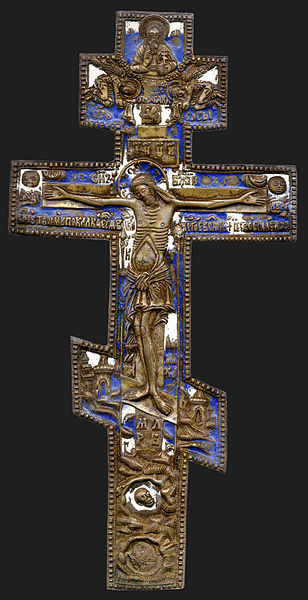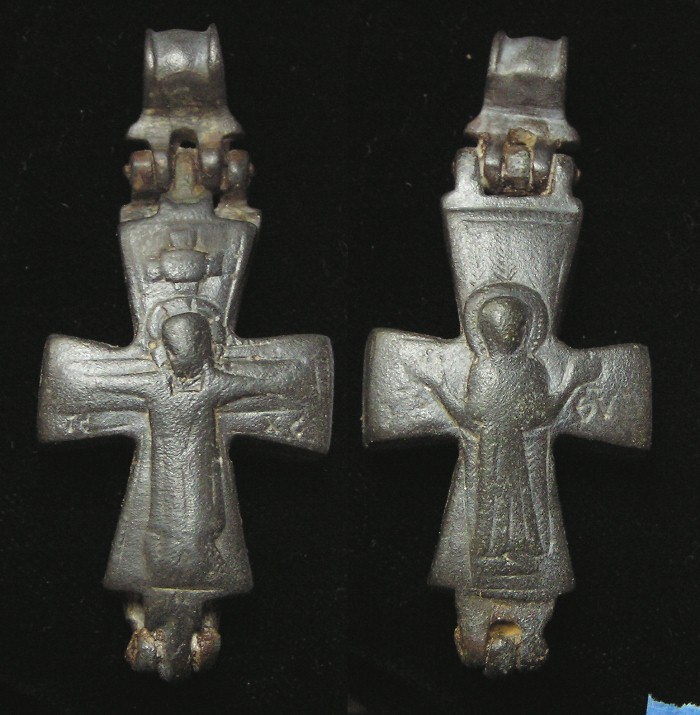 As today is the Feast of the Exultation of the Holy Cross, it may be of use and value to discuss the traditions surrounding the symbol which has become the emblem of our faith, the Cross.
As today is the Feast of the Exultation of the Holy Cross, it may be of use and value to discuss the traditions surrounding the symbol which has become the emblem of our faith, the Cross.Traditions are, in many ways, the defining characteristic of any organization. Perhaps the most recognizable and enduring tradition of our faith is the display or wearing of what has become the symbol of Christianity - the cross. Of course, which kind of cross is used is a defining tradition in and of itself.
The two major divisions come down to whether or not the corpus is present. For catholic christians (Roman, Orthodox, Anglican and others) and Lutherans, the cross with corpus, known more commonly as the crucifix, is venerated. For protestants (excepting the Lutherans), the cross is 'empty' or without a corpus. From there there are many specific variations depending on the sect, but I want to stay with the crucifix and the cross.
From the 4th century through the 13th century, one finds crosses being 'empty', adorned with various decorations as well as those with a corpus. Of interest, those which have a human form on the cross most frequently had two forms. On one side was a man with arms outstretched, representing the Christ crucified. On the other, the arms are raised in the position known as 'orans', meaning 'in prayer', representing the living or resurrected Christ. In all cases, the figures are integral to the cross, being enameled, cast or painted, and the image of Christ is depicted as a serene and gentle figure, clothed in robes and seemingly at peace with his fate as the Lamb of God on the one side and Shepherd of the flock on the other.
We see this 'double image' in personal crucifixes (those which would have been worn by people, as seen below) as well as altar and processional crosses. As time goes on, the general level of ornamentation increases to the entire cross until around the beginning of the 13th century, when the face of the crucifix showing the resurrected Christ is less emphasized, with more ornamentation being found associated with the Christ crucified.
From the 14th century to the Protestant Reformation, crucifixes with the resurrected Christ fade from view entirely, the 'reverse side' having general ornamentation to images of saints, religious figures or iconography of interest or to the patron/owner of the cross.
 The imagery of the crucified Christ also changes. The corpus becomes a three dimensional figure hanging from the cross, stripped to a loincloth, wounds bleeding and body wracked with pain, suffering and grief.
The imagery of the crucified Christ also changes. The corpus becomes a three dimensional figure hanging from the cross, stripped to a loincloth, wounds bleeding and body wracked with pain, suffering and grief.As part of the general rejection of 'all things catholic' and embrace of austerity, the Protestant faiths (Luther excepted), removed the corpus from the crucifix and chose to adopt a less ornate, 'new' symbol of faith.
I realize that there are a number of various arguments on both sides as to what the cross, both empty or with corpus, means and how important each one is with various theological reasons given, but as someone who has been on both sides of the argument, I believe it is prescient to recall that it is the image of a humiliated, half-naked, dying Christ, which the Protestants removed from the crucifix.
I was raised with the empty cross which symbolizes to me that Christ has Risen, but it doesn't capture the suffering endured for us. The standard crucifix of the catholic faith I have converted to, on the other hand, emphasizes the great sacrifice that Christ suffered for all our sakes, but leaves Him there, dead or dying. Both, to me, are lacking.
The old crucifix, however, has Christ crucified on one side and risen in glory on the other. That...that feels much more complete. Without the human suffering and death, the divine resurrection means nothing and without the divine resurrection, His death was for naught.
No comments:
Post a Comment